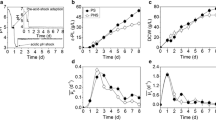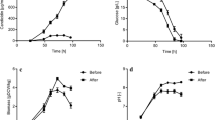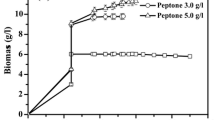Abstract
ε-Poly-l-lysine (ε-PL) is produced by Streptomyces as a secondary metabolite with wide industrial applications, but its production still needs to be further enhanced. Environmental stress is an important approach for the promotion of secondary metabolites production by Streptomyces. In this study, the effect of acidic pH shock on enhancing ε-PL production by Streptomyces sp. M-Z18 was investigated in a 5-L fermenter. Based on the evaluation of acidic pH shock on mycelia metabolic activity and shock parameters optimization, an integrated pH-shock strategy was developed as follows: pre-acid-shock adaption at pH 5.0 to alleviate the damage caused by the followed pH shock, and then acidic pH shock at 3.0 for 12 h (including pH decline from 4.0 to 3.0) to positively regulate mycelia metabolic activity, finally restoring pH to 4.0 to provide optimal condition for ε-PL production. After 192 h of fed-batch fermentation, the maximum ε-PL production and productivity reached 54.70 g/L and 6.84 g/L/day, respectively, which were 52.50 % higher than those of control without pH shock. These results demonstrated that acidic pH shock is an efficient approach for improving ε-PL production. The information obtained should be useful for ε-PL production by other Streptomyces.









Similar content being viewed by others
References
Shima S, Sakai H (1977) Polylysine produced by Streptomyces. Agric Biol Chem 41:1807–1809
Shih IL, Shen MH, Van YT (2006) Microbial synthesis of poly (ε-lysine) and its various applications. Bioresour Technol 97:1148–1159
Shima S, Matsuoka H, Iwamoto T, Sakai H (1984) Antimicrobial action of ε-poly-l-lysine. J Antibiot 37:1449–1455
Ren XD, Chen XS, Tang L, Sun QX, Zeng X, Mao ZG (2014) Efficient production of ε-poly-l-lysine from agro-industrial by-products by Streptomyces sp. M-Z18. Ann Microbiol. doi:10.1007/s13213-014-0913-0
Chen XS, Tang L, Li S, Liao LJ, Zhang JH, Mao ZG (2011) Optimization of medium for enhancement of ε-poly-l-lysine production by Streptomyces sp. M-Z18 with glycerol as carbon source. Bioresour Technol 102:1727–1732
da Silva GP, Mack M, Contiero J (2009) Glycerol: a promising and abundant carbon source for industrial microbiology. Biotechnol Adv 27:30–39
Zouari N, Achour O, Jaoua S (2002) Production of delta-endotoxin by Bacillus thuringiensis subsp kurstaki and overcoming of catabolite repression by using highly concentrated gruel and fish meal media in 2-and 20-dm3 fermenters. J Chem Technol Biotechnol 77:877–882
Parekh M, Formanek J, Blaschek H (1999) Pilot-scale production of butanol by Clostridium beijerinckii BA101 using a low-cost fermentation medium based on corn steep water. Appl Microbiol Biotechnol 51:152–157
Kahar P, Iwata T, Hiraki J, Park EY, Okabe M (2001) Enhancement of ε-polylysine production by Streptomyces albulus strain 410 using pH control. J Biosci Bioeng 91:190–194
Chen XS, Li S, Liao LJ, Ren XD, Li F, Tang L, Zhang JH, Mao ZG (2011) Production of ε-poly-l-lysine using a novel two-stage pH control strategy by Streptomyces sp. M-Z18 from glycerol. Bioprocess Biosyst Eng 34:561–567
Liu S, Wu Q, Zhang J, Mo S (2011) Production of ε-poly-l-lysine by Streptomyces sp. using resin-based, in situ product removal. Biotechnol Lett 33:1581–1585
Zhang Y, Feng X, Xu H, Yao Z, Ouyang P (2010) ε-Poly-l-lysine production by immobilized cells of Kitasatospora sp. MY 5-36 in repeated fed-batch cultures. Bioresour Technol 101:5523–5527
Beppu T (1995) Signal transduction and secondary metabolism: prospects for controlling productivity. Trends Biotechnol 13:264–269
Horinouchi S (2003) AfsR as an integrator of signals that are sensed by multiple serine/threonine kinases in Streptomyces coelicolor A3 (2). J Ind Microbiol Biotechnol 30:462–467
Rehm HJ, Reed G (1997) Biotechnology: products of secondary metabolism, 2nd edn. VCH A wiley company, Weinheim
Hayes A, Hobbs G, Smith CP, Oliver SG, Butler PR (1997) Environmental signals triggering methylenomycin production by Streptomyces coelicolor A3 (2). J Bacteriol 179:5511–5515
Kim CJ, Chang YK, Chun GT (2000) Enhancement of Kasugamycin production by pH shock in batch cultures of Streptomyces kasugaensis. Biotechnol Prog 16:548–552
Doull JL, Ayer SW, Singh AK, Thibault P (1993) Production of a novel polyketide antibiotic, jadomycin B, by Streptomyces venezuelae following heat shock. J Antibiot 46:869–871
Xu YN, Zhong JJ (2012) Impacts of calcium signal transduction on the fermentation production of antitumor ganoderic acids by medicinal mushroom Ganoderma lucidum. Biotechnol Adv 30:1301–1308
Himabindu M, Potumarthi R, Jetty A (2007) Enhancement of gentamicin production by mutagenesis and non-nutritional stress conditions in Micromonospora echinospora. Process Biochem 42:1352–1356
Nishikawa M, Ki Ogawa (2002) Distribution of microbes producing antimicrobial ε-poly-l-lysine polymers in soil microflora determined by a novel method. Appl Environ Microbiol 68:3575–3581
Hiraki J, Hatakeyama M, Morita H, Izumi Y (1998) Improved ε-poly-l-lysine production of an S-(2-aminoethyl)-l-cysteine resistant mutant of Streptomyces albulus. Seibutsukogaku 76:487–493
Winding A, Binnerup SJ, Sørensen J (1994) Viability of indigenous soil bacteria assayed by respiratory activity and growth. Appl Environ Microbiol 60:2869–2875
Rioseras B, López-García MT, Yagüe P, Sánchez J, Manteca Á (2014) Mycelium differentiation and development of Streptomyces coelicolor in lab-scale bioreactors: programmed cell death, differentiation, and lysis are closely linked to undecylprodigiosin and actinorhodin production. Bioresour Technol 151:191–198
Singh KP, Mahendra AL, Jayaraj V, Wangikar PP, Jadhav S (2013) Distribution of live and dead cells in pellets of an actinomycete Amycolatopsis balhimycina and its correlation with balhimycin productivity. J Ind Microbiol Biotechnol 40:235–244
Itzhaki R (1972) Colorimetric method for estimating polylysine and poly-arginine. Anal Biochem 50:569–574
AOAC International (formerly the Association of Official Analytical Chemists) (1995) Official Methods of Analysis Arlington. AOAC International, VA
Zeng X, Chen XS, Ren XD, Liu QR, Wang L, Sun QX, Tang L, Mao ZG (2014) Insights into the role of glucose and glycerol as a mixed carbon source in the improvement of ε-poly-l-lysine productivity. Appl Biochem Biotechnol 173:2211–2224
Yamanaka K, Kito N, Imokawa Y, Maruyama C, Utagawa T, Hamano Y (2010) Mechanism of ε-poly-l-lysine production and accumulation revealed by identification and analysis of an ε-poly-l-lysine-degrading enzyme. Appl Environ Microbiol 76:5669–5675
Even S, Lindley ND, Loubière P, Cocaign-Bousquet M (2002) Dynamic response of catabolic pathways to autoacidification in Lactococcus lactis: transcript profiling and stability in relation to metabolic and energetic constraints. Mol Microbiol 45:1143–1152
Fang QH, Zhong JJ (2002) Effect of initial pH on production of ganoderic acid and polysaccharide by submerged fermentation of Ganoderma lucidum. Process Biochem 37:769–774
Kim YJ, Song JY, Moon MH, Smith CP, Hong SK, Chang YK (2007) pH shock induces overexpression of regulatory and biosynthetic genes for actinorhodin productionin Streptomyces coelicolor A3(2). Appl Microbiol Biotechnol 76:1119–1130
Kim YJ, Moon MH, Song JY, Smith CP, Hong S-K, Chang YK (2008) Acidic pH shock induces the expressions of a wide range of stress-response genes. BMC Genom 9:604
Park YK, Bearson B, Bang SH, Bang IS, Foster JW (1996) Internal pH crisis, lysine decarboxylase and the acid tolerance response of Salmonella typhimurium. Mol Microbiol 20:605–611
Foster JW, Hall HK (1991) Inducible pH homeostasis and the acid tolerance response of Salmonella typhimurium. J Bacteriol 173:5129–5135
Tang YJ, Zhong JJ (2002) Fed-batch fermentation of Ganoderma lucidum for hyperproduction of polysaccharide and ganoderic acid. Enzyme Microb Technol 31:20–28
Acknowledgments
This work was financially supported by the National Natural Science Foundation of China (31301556), the Jiangsu Key Project of Scientific and Technical Supporting Program (BE2012616), the Cooperation Project of Jiangsu Province among Industries, Universities and Institutes (BY2013015-11), the Jiangsu Province “Collaborative Innovation Center for Advanced Industrial Fermentation” Industry Development Program, the Priority Academic Program Development of Jiangsu Higher Education Institutions, the 111 Project (111-2-06) and the National Natural Science Foundation of China (21376106).
Author information
Authors and Affiliations
Corresponding authors
Rights and permissions
About this article
Cite this article
Ren, XD., Chen, XS., Zeng, X. et al. Acidic pH shock induced overproduction of ε-poly-l-lysine in fed-batch fermentation by Streptomyces sp. M-Z18 from agro-industrial by-products. Bioprocess Biosyst Eng 38, 1113–1125 (2015). https://doi.org/10.1007/s00449-015-1354-2
Received:
Accepted:
Published:
Issue Date:
DOI: https://doi.org/10.1007/s00449-015-1354-2




